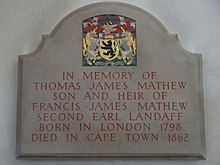Francis Mathew, 2nd Earl Landaff
2nd Earl Landaff Francis James Mathew KP | |
|---|---|
 Viscount Mathew and his brothers by Gillray, 1803: The Three Mr Wiggins's. The title is a reference to that year's play Mrs Wiggins by John Till Allingham. | |
| Born | 20 January 1768 |
| Died | 12 March 1833 Dublin |
| Style | The Honourable (1783–1797), Viscount (1797–1806) |
| Title | 2nd Earl Landaff |
| Predecessor | Francis Mathew |
| Successor | Title became extinct |
| Spouse | Gertrude Cecilia La Touche |
| Children | None |
| Parent | Francis Mathew |
| Relatives | Montague James Mathew (brother) |

Francis James Mathew, 2nd Earl Landaff KP (20 January 1768 – 12 March 1833), styled The Honourable Francis Mathew from 1783 to 1797 and Viscount Mathew from 1797 to 1806, was an Irish peer and politician.
Mathew sat for County Tipperary in the Irish House of Commons from 1790 to 1792, when his election was declared invalid. He represented Callan between May and November 1796 and subsequently again Tipperary in the Irish House of Commons until the Act of Union in 1800 and then the United Kingdom House of Commons from 1801 until he succeeded his father in the earldom in 1806. His younger brother Montague James Mathew (1773–1819) succeeded him as one of the two members of the UK parliament for County Tipperary. He was an opponent of the Union and a supporter of Catholic Emancipation, and was also "a personal enemy of George IV" and gave evidence in favour of Queen Caroline regarding her conduct at the Court of Naples during her famous trial.[citation needed]
He was appointed a Knight of the Order of St Patrick on 24 November 1831.[1]
Lord Landaff married Gertrude Cecilia, a daughter of John La Touche, of Kildare. The marriage was childless. He died of syncope in Dublin on 12 March 1833, aged 65, when the titles became extinct. Dying intestate, his estates went to his sister, Lady Elizabeth Mathew, who died in 1842 leaving the fortune to a cousin, the Vicomte de Chabot, the son of her mother's sister Elizabeth Smyth.[2]
References
- ^ Rayment, Leigh. "Knights of the Order of St Patrick". Archived from the original on 7 June 2008. Retrieved 13 December 2008.
- ^ Sir Bernard Burke, A genealogical history of the dormant, abeyant, forfeited, and extinct peerages of the British empire (1866), p. 361
